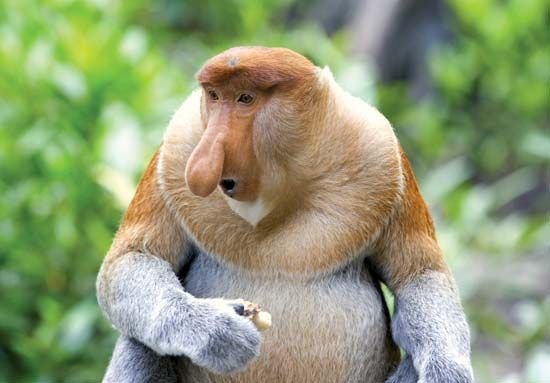
The proboscis monkey, native to the lush rainforests of Borneo, is more than just a pretty face. It plays a vital role in its habitat, helping to disperse seeds and keep the forest thriving. However, their numbers are dwindling, and many experts are raising alarms. In this article, we’ll dive into the conservation status of the proboscis monkey, the reasons for their decline, and what can be done to turn the tide. Ready for a journey into the world of wildlife conservation? Let’s go!
What Makes the Proboscis Monkey Unique?
You may think that all monkeys are similar, but the proboscis monkey is like the quirky cousin at a family reunion. This species is known for its distinctive physical traits. Males, especially, showcase a large, fleshy nose that can be up to 4 inches long! This nose isn’t just for show; it helps them attract mates. Imagine a peacock fanning its feathers, but in this case, it’s all about the nose.
Proboscis monkeys also have a unique diet. They primarily eat leaves, fruits, and seeds, which are abundant in their swampy, tropical habitat. Their long limbs and strong hands make them excellent climbers, allowing them to navigate through the dense canopy. You might spot them swinging from branch to branch, enjoying their meals like they’re having a picnic in the trees, which sounds pretty ideal, right?
Habitat and Behavior
Proboscis monkeys are social creatures, often found in groups, sometimes consisting of 10 to 30 individuals. These groups are typically led by a dominant male, who defends the territory and keeps an eye out for predators. Their social structure is fascinating—like a little community that relies on cooperation for survival.
These monkeys are also known for their remarkably loud vocalizations. Their calls can be heard echoing through the forest, which helps them communicate with one another. So, picture a lively chat happening high up in the trees! Unfortunately, these social creatures are becoming increasingly isolated due to habitat loss.
Are Proboscis Monkeys Endangered?
Yes, proboscis monkeys are classified as endangered on the International Union for Conservation of Nature (IUCN) Red List. Their population has greatly declined over the years, primarily due to habitat destruction and hunting. You might be wondering, what does that mean in numbers? Estimates suggest that fewer than 50,000 remain in the wild, and their numbers continue to dwindle.
The primary threat is deforestation caused by logging, agriculture, and palm oil plantations. As their natural habitat shrinks, these monkeys struggle to find food and suitable places to live. For them, every tree felled is like losing a part of their home. It’s a sad reality that affects not only the monkeys but the entire ecosystem they inhabit.
Hunting and Poaching
Beyond habitat loss, hunting poses another significant threat. In some areas, proboscis monkeys are hunted for their meat or captured for the illegal pet trade. Despite their protected status, enforcement of these laws is often weak. This is troubling because the hunting of these monkeys disrupts social groups and further impacts their dwindling population.
Moreover, when hunting occurs, it creates a ripple effect in the ecosystem. Animals like the proboscis monkey help maintain the balance in their environment. Losing them isn’t just a loss for wildlife enthusiasts; it can lead to a broader ecological imbalance.
Conservation Efforts for the Proboscis Monkey
So, what can be done to help the proboscis monkey? Thankfully, several organizations are dedicated to their conservation. Efforts include habitat protection, anti-poaching initiatives, and community education programs. By raising awareness about the challenges these monkeys face, conservationists aim to inspire collective action.
Protected Areas: One significant way to support conservation is to establish protected areas where proboscis monkeys can thrive without threats. National parks and wildlife reserves play a crucial role in safeguarding their habitat. These zones not only protect the monkeys but also preserve biodiversity, supporting countless other species.
Community Involvement: Engaging local communities is also key. When people understand the importance of protecting wildlife, they’re more likely to participate in conservation efforts. This might include eco-tourism, which provides economic benefits and fosters a sense of pride in their natural heritage.
Research and Monitoring
Regular research and monitoring of proboscis monkey populations are essential to track their progress and challenges. Scientists work to understand their behaviors, reproduction, and habitat use better. This data is invaluable for developing effective conservation strategies.
By studying their movements and social interactions, researchers can determine which areas are crucial for their survival. It’s like piecing together a puzzle that helps conservationists see the bigger picture.
How You Can Help
You might be feeling motivated to make a difference after learning about these incredible monkeys. There are several ways you can contribute to their conservation. First, consider supporting organizations that focus on wildlife protection. Whether it’s through donations or volunteering, every bit helps.
Another way is to spread awareness. Share what you’ve learned with friends and family. You can even advocate for sustainable products, like supporting brands that use eco-friendly palm oil. Your choices can drive demand for practices that protect wildlife habitats.
Stay Informed: Keeping yourself educated about endangered species can also make you a more effective advocate. Follow conservation news, read articles, and engage in discussions. The more you know, the better equipped you are to make an impact.
Final Thoughts
In the grand tapestry of life on Earth, every thread matters—even those as quirky as the proboscis monkey. Their struggle reflects a broader narrative about the health of our planet. By understanding the challenges they face and the efforts to protect them, you can be part of the solution. Whether it’s educating others, changing your consumer habits, or simply appreciating the beauty of wildlife, every step counts.
Together, we can help ensure that these fascinating creatures continue to swing through the trees of Borneo for generations to come. The world needs more unique animals like the proboscis monkey, and it’s up to us to protect them.
